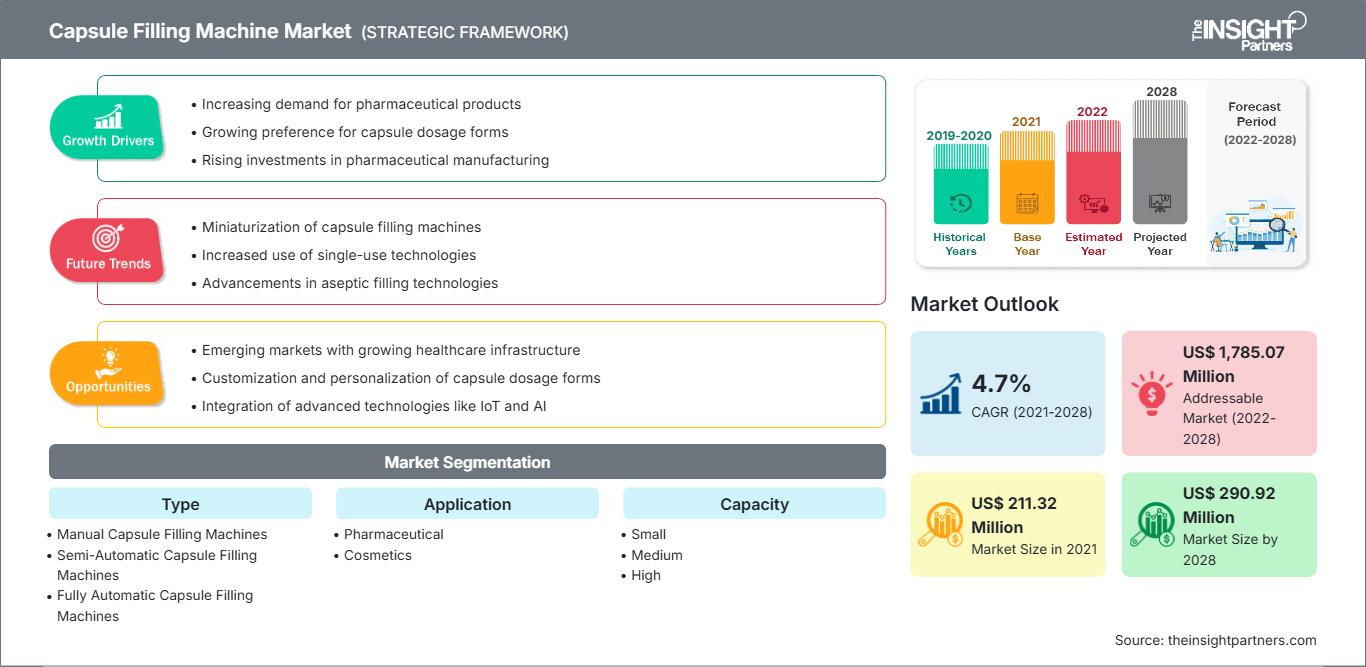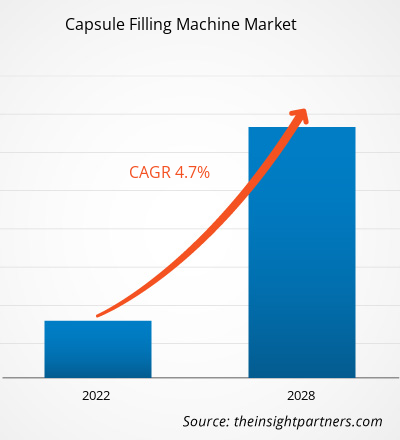[研究报告]胶囊填充机市场规模预计将从2021年的2.1132亿美元增至2028年的2.9092亿美元;预计2021年至2028年期间的复合年增长率为4.7%。
胶囊填充机,也称为封装机,是一种广泛应用于制药和工业领域的机械设备。这些机器将粉末、颗粒、半固体或液体(载有活性药物成分或活性药物成分与赋形剂的混合物)填充到各种尺寸的空软胶囊或硬胶囊中。这些机器广泛应用于化工、制药、动物饲料以及食品和饮料等行业。全球约有1600台用于各种类型胶囊填充机的安装。
胶囊填充机市场的增长得益于胶囊填充机技术的进步以及慢性病发病率的上升。然而,胶囊填充机的高生产成本阻碍了市场的增长。
自定义此报告以满足您的要求
您将免费获得任何报告的定制,包括本报告的部分内容,或国家级分析、Excel 数据包,以及为初创企业和大学提供超值优惠和折扣
胶囊填充机市场: 战略洞察

-
获取本报告的主要市场趋势。这个免费样本将包括数据分析,从市场趋势到估计和预测。
市场洞察慢性病患病率上升推动胶囊填充机市场
心血管疾病 (CVD)、癌症、糖尿病、中风和肾脏疾病等慢性疾病的患病率上升,增加了对胶囊填充机的需求,以促进药用胶囊的生产。据世界卫生组织称,心血管疾病是全球最大的死亡原因,每年导致 1790 万人死亡。此外,糖尿病患病率上升增加了对药用胶囊的需求,从而推动了对胶囊填充机的需求增加。根据国际糖尿病联合会第九版《糖尿病图谱》,2019 年约有 4.63 亿成年人 (20-79 岁) 患有糖尿病,预计到 2045 年这一数字将达到 7 亿。癌症患病率的上升也推动了对胶囊填充机的需求。根据世界卫生组织的数据,癌症是全球第二大死亡原因,2018年导致960万人死亡。全球慢性肾病病例激增,也增加了对日常药物的需求,这反映在市场的增长上。美国国家糖尿病、消化和肾脏疾病研究所在一份报告中指出,2018年超过661,000名美国人患有肾衰竭,其中468,000人需要透析和日常药物治疗。由于慢性疾病和感染的发病率不断上升,药品需求迅速增长,凸显了胶囊填充机的重要性。
基于类型的洞察
胶囊填充机市场按类型分为手动胶囊填充机、半自动胶囊填充机和全自动胶囊填充机。 2021 年,全自动胶囊填充机占据了最大的市场份额。此外,预计在预测期内,该细分市场将实现最高的复合年增长率。
基于应用的洞察
按应用划分,胶囊填充机市场可分为制药、化妆品和其他领域。2021 年,制药领域占据了最大的市场份额。此外,预计该领域将在 2021 年至 2028 年达到最高水平。
基于产能的洞察
按产能划分,胶囊填充机市场分为小型(最多 50,000 粒胶囊)、中型(每小时 50,000 至 100,000 粒胶囊)和大型(每小时超过 100,000 粒胶囊)。 2021年,小型胶囊(最多50,000粒胶囊)占据了最大的市场份额。此外,预计该细分市场在2021年至2028年期间的复合年增长率将达到5.0%。
产品发布和审批是企业扩大全球业务和产品组合的常用策略。此外,胶囊填充机市场参与者注重合作战略,以扩大客户群,从而在全球范围内维护其品牌。
胶囊填充机市场
The Insight Partners 的分析师已详尽阐述了预测期内影响胶囊填充机市场的区域趋势和因素。本节还讨论了北美、欧洲、亚太地区、中东和非洲以及南美和中美洲的胶囊填充机市场细分和地域分布。
胶囊填充机市场报告范围
| 报告属性 | 细节 |
|---|---|
| 市场规模 2021 | US$ 211.32 Million |
| 市场规模 2028 | US$ 290.92 Million |
| 全球复合年增长率 (2021 - 2028) | 4.7% |
| 历史数据 | 2019-2020 |
| 预测期 | 2022-2028 |
| 涵盖的领域 |
By 类型
|
| 覆盖地区和国家 |
北美
|
| 市场领导者和主要公司简介 |
|
胶囊填充机市场参与者密度:了解其对业务动态的影响
胶囊填充机市场正在快速增长,这得益于终端用户需求的不断增长,而这些需求又源于消费者偏好的不断变化、技术进步以及对产品优势的认知度不断提升等因素。随着需求的增长,企业正在扩展产品线,不断创新以满足消费者需求,并抓住新兴趋势,从而进一步推动市场增长。

- 获取 胶囊填充机市场 主要参与者概述
公司简介
- ACG
- Capsugel, Inc(Lonza Group AG 子公司)
- Schaefer Technologies
- Syntegon Technology GmbH
- Torpac Inc.
- 浙江富昌机械有限公司
- 北京翰林航宇科技发展有限公司
- M2G Srl;
- IMA Industria Macchine Automatiche SpA
- 历史分析(2 年)、基准年、预测(7 年)及复合年增长率
- PEST和SWOT分析
- 市场规模、价值/数量 - 全球、区域、国家
- 行业和竞争格局
- Excel 数据集
近期报告
相关报告
客户评价
购买理由
- 明智的决策
- 了解市场动态
- 竞争分析
- 客户洞察
- 市场预测
- 风险规避
- 战略规划
- 投资论证
- 识别新兴市场
- 优化营销策略
- 提升运营效率
- 顺应监管趋势






















 获取免费样品 - 胶囊填充机市场
获取免费样品 - 胶囊填充机市场